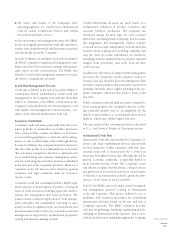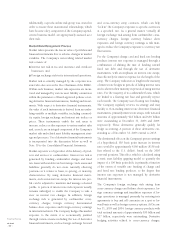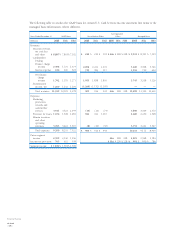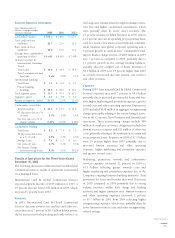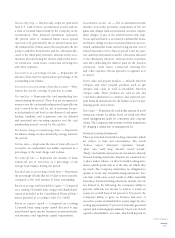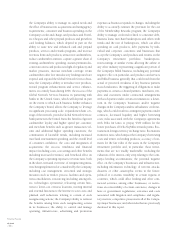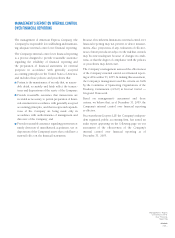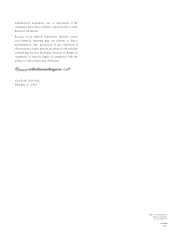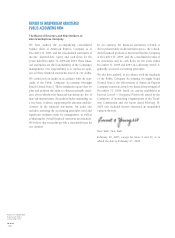American Express 2005 Annual Report Download - page 55
Download and view the complete annual report
Please find page 55 of the 2005 American Express annual report below. You can navigate through the pages in the report by either clicking on the pages listed below, or by using the keyword search tool below to find specific information within the annual report.accounts payable-related funding benefit, partially offset
by greater salary and benefit costs, which reflect head-
count growth due to Global Network Services business-
building initiatives.
The effective tax rate was 35 percent in 2005 versus 36
percent in 2004 and 37 percent in 2003. The effective
tax rate was lower in 2005 as compared to 2004 prima-
rily as a result of favorable tax audit experience.
Corporate & Other
Corporate & Other had net expense of $111 million,
$187 million and $264 million in 2005, 2004 and 2003,
respectively. Net expense in 2005 reflects $159 million
of tax benefits resulting from the resolution of prior
years’ tax items, a $73 million ($47 million after-tax)
benefit related to the settlement of an insurance claim
associated with September 11, 2001 and $105 million
($68 million after-tax) of reengineering costs.
Airline Industry Matters
Historically, the Company has not experienced signi-
ficant revenue declines resulting from a particular
airline’s scaling-back or closure of operations due to
bankruptcy or other financial challenges because the
volumes generated from the airline are typically shifted
to other participants in the industry that accept the
Company’s card products. Nonetheless, the Company is
exposed to business and credit risk in the airline indus-
try primarily through business arrangements where the
Company has remitted payment to the airline for a card-
member purchase of tickets that have not yet been used
or “flown.” This creates a potential exposure for the
Company in the event that the cardmember is not able
to use the ticket and the Company, based on the facts
and circumstances, credits the cardmember for the
unused ticket. Historically, this type of exposure has not
generated any significant losses for the Company
because of the need for an airline that is operating under
bankruptcy protection to continue accepting credit and
charge cards and honoring requests for credits and
refunds in the ordinary course of business, and in fur-
therance of its reorganization and its formal assumption,
with bankruptcy court approval, of its card acceptance
agreement, including approval of the Company’s right to
hold cash to cover these potential exposures to provide
credits to cardmembers. Typically, as an airline’s finan-
cial situation deteriorates the Company delays payment
to the airlines thereby increasing cash held to protect
itself in the event of an ultimate liquidation of the airline.
The Company’s goal in these distressed situations is to
hold sufficient cash over time to ensure that upon liq-
uidation the cash held is equivalent to the credit expo-
sure related to any unused tickets.
Separately, as part of Delta Airlines’ (Delta) decision to
file for protection under Chapter 11 of the Bankruptcy
Code, the Company agreed with Delta to restructure cer-
tain of its financial arrangements with the airline. In par-
ticular, Delta agreed to repay to the Company an aggre-
gate $557 million, primarily the Company’s prepayment
of Delta SkyMiles rewards points. Contemporaneously
with the repayment, the Company lent to Delta
$350 million as part of Delta’s post-petition, debtor-in-
possession (DIP) financing under the Bankruptcy Code.
At December 31, 2005 the remaining principal balance
was $300 million. This post-petition facility continues
to be structured as an advance against the Company’s
obligations to purchase Delta SkyMiles rewards points
under the Company’s co-brand and Membership
Rewards agreements and will be amortized ratably each
month beginning in July 2006 through November
2007. The Company’s post-petition facility is secured by
(i) senior liens on Delta assets specifically related to its
American Express co-brand, Membership Rewards and
card acceptance relationships and (ii) liens subordinate
to senior liens on all other Delta assets including the
assets and shares of certain Delta subsidiaries.
In addition, given the depth of the Company’s business
relationships with Delta through the SkyMiles Credit
Card and Delta’s participation as a key partner in the
Company’s Membership Rewards program, in the event
Delta’s reorganization under the bankruptcy laws is not
successful or otherwise negatively impacts the Compa-
ny’s relationship with Delta, the Company’s future finan-
cial results could be adversely impacted. As previously
disclosed, American Express’ Delta SkyMiles Credit
Card co-brand portfolio accounts for less than 10 per-
cent of the Company’s worldwide billed business
and less than 15 percent of worldwide managed lend-
ing receivables.
Other Reporting Matters
Accounting Developments
See Recently Issued Accounting Standards section of
Note 1 to the Consolidated Financial Statements.
Financial Review
AXP / AR.2005
[53 ]


